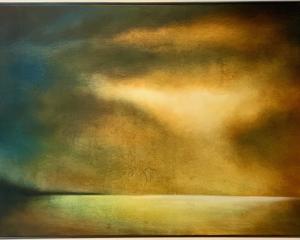James Dignan takes in some exhibitions.

We Saw You There, Inge and Marc Doesburg (Olga)
A joint exhibition by husband and wife Marc and Inge Doesburg provides a memorable display at Olga.
Most of the pieces are provided by Marc Doesburg. His photographic works show transition zones, those haunting places glimpsed in passing on the way to a destination. The artist uses chiaroscuro techniques to present structures as light forms within an overwhelming negative space, letting the structures float as if in a galactic void. The images are prosaically named with just location and year, adding to their anonymity. The crisp, clear shapes of pieces such as ‘‘Frankfurt 2024’’ and ‘‘Dusseldorf 2023’’ render these works pure studies of line and light.
Inge Doesburg provides three larger works which perfectly complement the harsh delineations of Marc’s images.
These pieces are natural landscapes, viewed through a heavy mist. The ambiguity here is not with location but with form, and the subject is untouched by the straight lines of human construction. The intriguing use of transparent film as a canvas adds an inner sheen to two of the pieces, while the largest, ‘‘Chatham Islands’’, beautifully depicts a rain-drenched land under an acrylic wash of tenebrous cloud, floating on a blackened sea.
The works, though all monochrome, swim in subtle tones from steel blue to sepia brown, adding extra emotional depth to their subject matter.

Bluebird on a Booze-Tree, Jonathan Cuming
(Brett McDowell Gallery)
Jonathan Cuming provides a dark surrealism in his mixed-media works at Brett McDowell Gallery.
The artist’s expressionist works, in strong blocks of colour, are heavily worked with strokes and lines of graphite and coloured pencil, producing images that follow a New Zealand artistic path previously trodden by the likes of Philip Clairmont and Jeffrey Harris. One point of difference with these precedent-setters is the wry black humour of his works, brought into sharp focus by the pathos of his deadpan titles.
The combination of the bright colours and wilfully childlike nature of Cuming’s images alleviates any darkness that the satirical material might inspire. ‘‘A Drowning’’ becomes as a scene from a Mr Bean episode; ‘‘Making Ends Meat’’, despite its dark commentary on poverty, remains a bright, almost joyous image. ‘‘Brolly Spiders’’ become children’s toys, rather than the creatures which shocked the artist when they fell from a neglected umbrella.
The works surround a central ‘‘found statue’’, a worked tree-branch deposited by the tide, which now becomes the gleeful dancing figure of a ‘‘Driftwood Christ’’. A second found object construction, the Duchamp-like ‘‘Doublehappy’’, couples the internal workings of an animal trap with a discarded basketball hoop to create a thought-provoking yet ambiguous installation.

(Fe29 Gallery)
Fe29’s latest exhibition, ‘‘Journey into the Unknown’’, presents the work of ceramicist Gerda Satunas.
Satunas is a Lithuanian-born New Zealander whose art career has followed a shift of media akin to the artist’s own travels across the world.
Beginning as a fashion designer, Satunas travelled to New Zealand after working in fabric in various cities throughout Europe, and continued her chosen artistic field on arriving in this country, being named as a finalist in the 2016 iD Fashion Week.
It was in Dunedin that Satunas’s love of ceramics was sparked. Combining this with an abiding love of the natural world, especially the shoreline, she has created a series of works that focus on the forms of ferns and seaweed, shimmering in the sunlight and ripples of the sea.
The strong works, with their heavy glossy glaze, are in the form of clay and porcelain wall hangings and vessels, the foliage-inspired strands flowing freely to suggest a mass of vegetation flowing in the water or wind.
Satunas’s works form a journey, and are an expression of the homesickness which often accompanies travels across the world. Although constantly flowing, the seaweed and plants tug at their stems, simultaneously desiring freedom and pinned forever to their roots, both literal and psychological.











!["Flux" featuring Portraits of Geoff Dixon (2021–2025), acrylic on paper [installation view], by...](https://www.odt.co.nz/sites/default/files/styles/odt_landscape_small_related_stories/public/story/2025/07/1_macleod.jpg?itok=2n5TYmHs)
